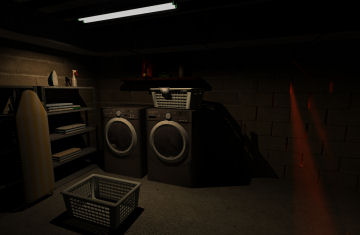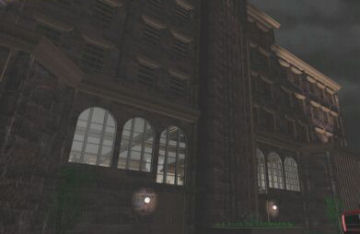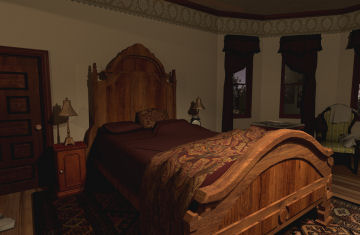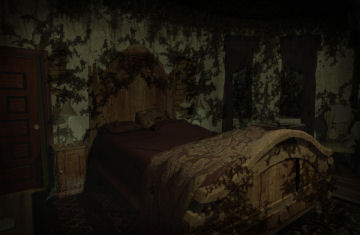|
A Fireside Chat with Wicked Cinder
GameBoomers Interviews
Bryan Wiegele and Nate Ferguson
By Becky Waxman

GameBoomers:
Could you tell us a bit of your background, and how you came to be
involved in adventure game development?
Nate Ferguson (VP of Development at
Wicked Cinder):
My background includes a lot of varied jobs and interests. I started
working in 3d applications at 14 and never quit. I was involved in art
classes from middle school into college. I did graphic design and web
design for several years before going to the Art Institute of Phoenix
where I got a Game Art and Design degree. After that, I got a job at
Idol Minds as an environment artist. After a year in art, I switched to
game design. After Idol Minds, Bryan and I teamed up to work on decay and
begin Wicked Cinder.
Bryan Wiegele (President of Wicked
Cinder): I started with
adventure games back in 1995 when I began work on a horror adventure
game called Inherent Evil. Since then Iíve worked on three
volumes of the Delaware St. John series in addition to a series of
casual games. I very much enjoy working on adventure games because of
the importance of narrative. Telling stories is a lot of fun and no
group really appreciates the story of a game like the adventure
community.
GB:
Tell us about your new company, Wicked Cinder.
BW:
Nate and I founded WC last year while working on decay.
NF:
Right now we're in the nascent stages of
development and team building. We will be developing several titles over
the next few years. We've got a sound plan and will be following that in
order to provide high quality games to both casual and more hardcore
gamers. It's extremely exciting and we have some really interesting
titles in the works.

GB:
What's happening now with the Delaware St. John series? Is the series
still on hold? We've noticed the
"Alone: Asylum of The Lost" Prologue story
on the Delaware St.
John website. Is this an indication that Episode 4 is currently under
development? If not, what would it take for us to see another Delaware
episode?
BW:
The development on Delaware 3 was a monster. We had just gotten a
publisher who was going to take over all of the distribution of the
games but at the same time wanted input into the game as well. After
Delaware 3 I intended to go right into 4 but it wasnít meant to happen
then. When the publisher folded we had to rethink our development plan.
The good news about the Delaware series is weíre currently working on
the development plan for the next few Delaware games.
NF: Yeah, you'll
be seeing Delaware again real soon.
GB:
Is Inherent Evil 2 still a possibility?
NF:
We have a lot of options
available in terms of developing future titles.
BW: And IE2 is
right up there. Iíve had the plan for the second game ready for years
now so itís going to come around in the near future. Itís beyond
something I want to do, I need to do it!

GB:
What's happening with the upcoming game, decay? How will it differ
from the Delaware St. John games? Is it part of a series?
NF:
At this time, decay is getting close to having a big section of
the game polished and ready for testing. There's still a lot to do, but
we're making steady progress, and the game is shaping up very nicely.
BW:
Yeah itís really shaping up great. There are two changes players are
going to notice immediately. The first is the resolution of the game has
been increased to provide larger display and sharper looking graphics.
The second is we now support fully animated scenes in game. So when
youíre in a room with a fireplace, itís burning and casting light on the
room. Or if itís raining outside when you stand by the window you can
watch it coming down outside. This addition is amazing. It really makes
the game feel that much more alive, that youíre really exploring a
living environment.

GB:
Quoting from the
decay website:
"The dream home the family
moved into shortly before the accident suddenly begins to rot from the
inside, trapping Jacob in a twisted labyrinth of mystery and terror. As
the walls rot away, rooms that weren't there previously are exposed for
Jacob to explore."
Why are buildings -- houses, hotels,
theaters, etc. -- so important in horror-based adventures?
NF: I
don't know if buildings are necessarily important so much as a
convenient means to restrict movement, obscure objectives, and separate
the player from 'the world at large' ie isolate them from the
character's regular environment. The very presence of walls and doors
also lends itself to building of suspense by making the player fear
turning a corner, opening a door, or ascending the stairs. Other methods
are available of course, but buildings lend themselves particularly
well, by necessity, to partition of space. The smaller the space, the
greater the feeling of claustrophobia or impending doom. Careful use of
the spaces and the sizes can allow the developer to control the mood and
experience of the player with greater precision.
BW: I think for me
itís not necessarily the space itself thatís effective at making a scene
scary, I think itís locations that should be populated but are not. An
amusement park is the least likely place to be scared. But simply remove
the people and now somethingís wrong, places like this should never be
empty. I think the feeling of comfort and safety are removed when a
person is alone in a location like that.

GB:
Why are themes associated with childhood -- dolls, clowns, amusement parks
-- so affecting when placed into a creepy, atmospheric game?
NF: I hate
small, creepy children, followed closely on the do-not-want list by
diminutive clowns. The main reason I think that these are places that
most people find creepy is that it is an invasion of places that we felt
we were safe and protected as children. The perversion of this idea of
safety, the infiltration of this protected area, and the corruption of a
place that we enjoyed as children is significantly disturbing.
Furthermore, I think it may teleport us to a place where we feel like
children again. Therefore, not only do things feel more threatening and
terrifying, but we feel more helpless to fight against whatever evil may
be present, while the player is in that mind state.
BW: I agree with
that. Iíll also say most peopleís perceptions change as they get older.
What is perceived as magical and fantastic as kids seems to change to
creepy as people get older. I had a friend tell me upon a recent viewing
of ďThe Neverending StoryĒ that they didnít remember the luck dragon,
Falcor, being so ďcreepyĒ when they were a kid and saw the movie. Why is
it creepy now when it was a great fantasy to the same person when they
were a child? As the question points out, a lot of the themes associated
with the wonder and interests of childhood turn dark as we get older.

GB:
How much background story do you usually create for a game? How much
actually gets used in the game?
NF: I make
the story pretty. Asset creation is an interesting process. The main
pass is all the game play objects and the landmark pieces that will
define a particular title. The rest of the assets that have to be
created become like descriptions in a story, adding detail, atmosphere,
and history to a scene. The balance becomes completing enough assets in
the time frame given to enhance the space's purpose for relating the
story to the player, without spending too much time on asset creation or
by making the scene too cluttered. So I guess this relates to the
question in the way that we do create a lot of assets and use most of
them. Sometimes a piece just doesn't fit, visually, and other times
there may not be room. Other times the story has changed such that the
object created is no longer needed. In that case though, we just
re-purpose the object. But, for the most part, the majority of the art
that is made makes it into the game.
BW: Nateís example
of how details in the environment can enhance the story without words is
overlooked often in games. For example, if the setting is a familyís
house, little details like the expression of the characters in
photographs can tell a lot about the characters without having to
actually read or watch the characters interact.
For
me the story always starts as the skeleton and as the game is in
development the meat builds on the bones. For decay the story of
each of the characters is there to be discovered, very little of the
background of the characters didnít make it into the game.
By
comparison the Delaware games have a lot of background story that
doesnít really come to surface in the games. And itís not like we set
out to leave it out intentionally, itís just more likely not the
appropriate time to release the information. So thereís a huge
background story in the Delaware series thatís been there for the
existing three games but wonít actually come to light until later games
in the series.

GB:
How has the Indie development scene changed since you first became
involved? What kind of future do you foresee for Indie games?
NF:
This is my first foray into Indie development. The risk seems to be a
bit greater and so do the rewards. The kind of future I foresee for
Indie games is one of prosperity and a more widespread market. With the
addition of distribution channels like Steam, the Apple Store, Big Fish,
and the Xbox Indie Channel itís becoming much easier for game developers
with small budgets to get their game seen by the greater public. Also,
as downloadable media becomes even more widespread and is seen as a
viable method of buying a product, the wider the audience will become.
This further increases the amount of exposure Indie developers can
garner without spending publisher-type money on PR, boxed-distribution,
and advertising.
BW:
I think the overall quality of independent games has improved and seems
to be on a path to keep doing so. The surge of casual games has created
a market for games that are completely achievable by independent game
developers. I think the future is very bright for independent developers
as more technology comes into their grasp and itís only getting easier
to get independent games released.
GB:
Describe a day-in-the-life of an Indie developer/development team.
BW: For most indie
developers, at least the majority of ones that werenít lucky enough to
get funded entirely, an indie project is basically a job after the job.
For me I work a 40+ hour week and then on nights and weekends I get my
time in on the project. This can get very hairy when your day job
suddenly demands more time from you. It not only cuts into the time you
need to work on your indie project but it tires you out faster so youíre
less productive when you need to be more so. But at the end of the day
you have a lot of love for your side project so you do find the energy
to keep working on it.
NF: A
typical day for me is: wake up, run, eat breakfast, work, lunch, work,
dinner, work, sleep. Snowboard a few times during the week as a pressure
relief/time off/time away. Also, I spend a fair amount of time on IM and
Google wave with other team members coordinating tasks and other
concerns. Work, to answer more in detail, varies at times, but right now
it's email and such, then polishing each of the items in each room
throughout each floor of the house, as well as adding objects as needed,
which requires modeling and texturing of each new object. Then, it's
lighting for mood and realism and then test renders and tweaking, ad
nauseam.
GB:
Has your development team changed much since the release of Delaware
St. John Volume 3: The Seacliff Tragedy? How will this affect future
releases?
NF: Faster
computers plus more people equals win. This also applies to future
releases as we will be able to produce more content at a relatively
quick pace. Also, having a steady team will allow us to progress more
quickly on the next title, as everyone will expect what is to come and
what needs to be accomplished.
BW: Also, weíre
working with a lot of new talented people. Toph Macier is our audio
designer who did all of the music for decay and is currently
working on music for another game. (To listen to musical samples from
decay,
click here.) Heís really talented and
he just graduated high school last year! Weíve also got a few new team
members that love adventure games and want to contribute their own
flavor to the genre.
GB:
Do you think that the concept of episodic game releases has proven to be a
success? Any ideas as to how to keep gamers interested between episodic
releases? How hard is it to develop an overall story arc when you are
creating episodic releases?
NF: Episodic
releases allow the developer to release content on a steady schedule.
Especially for smaller teams, this episodic release schedule allows them
to tell the whole story over time without the pressure of having to get
the whole story into one game. It also allows the developer to release a
chapter at a time instead of having to finish, polish and release the
entire game. The rate at which the smaller games are produced would make
releasing the entire story at once time-prohibitive. In the greater
scheme of games, I think that we are seeing development of this idea.
Games that release extra chapters, more downloadable content, and other
aspects that extend the life of a single game are becoming more
prevalent. True episodic content is usually reserved for smaller games,
but the extra chapters option for games is getting close. In my mind, as
long as you stick to the loose story arc and develop the details that
flesh out the story later on, sticking to the arc is not really a
concern. It seems that the only thing that could derail that would be
technical or artistic limitations that may rule out developing the game
for certain in-game locations or things of that nature.
BW: Episodic games
are extremely tricky. When we first set out to do the Delaware games we
knew we couldnít do a large scale game with the amount of money we had
to work with so the idea of breaking it up into pieces was attractive.
Ideally youíd complete an episode and then itíd sell well to fund the
development of the subsequent episodes. However, what we didnít
anticipate is the ďprove itĒ mentality that weíd go up against. The
first volume of the Delaware games released to an audience with a lot of
doubts. People would say ďgreat, another episodic game that theyíll stop
making half way through and never completeĒ and with that, they passed
on the game. On that same note when Delaware 2 released we saw a spike
in Delaware 1 sales. We saw the same increase when Delaware 3 came out.
With each subsequent release we kinda won over previous doubters that
didnít want to invest out of the chance the series didnít get finished.
Itís a really nasty catch 22 and itís completely up to the audience. No
game that sells a lot of copies isnít going to get a sequel or two. But
not purchasing a game out of fear the series might stop, thatís a
self-fulfilling prophecy as no sales guarantees no sequels.
As
far as coming up with the story you start with the global story you want
to tell. Then the trick is making self-contained episodes that are
complete in themselves yet further the overall story. I always find the
story tends to just write itself after a while. Starting is the hard
part but once youíve established characters their actions just seem to
drive the story.
GB:
How important is digital downloading in current game sales? Will we ever
get an accurate "read" on the numbers of digital sales versus published
disk versions of the same game? What has your experience been in selling
your games via download versus selling disk versions?
NF: Digital
downloads are becoming much more widespread. I think that digital
downloading is becoming very important for several reasons. The first is
that the developer has a more accessible channel to distribute and
publish games and is much more affordable. The second is that the
developer, through not being reliant on a publisher, retains more rights
to its intellectual property. And lastly, piracy is less of a concern.
More platforms are supporting download only content, on both pc and
consoles for these reasons.
I'm
not 100% on this, but I believe the information provided to developers
on downloaded titles is more accurate and more readily available than
box sales numbers.
BW: With every
indie game Iíve released so far a pirated version of the game has been
released within 2-3 days of the game's release. This means that someone
actually goes out of their way to be one of the first purchasers with
the sole intention of either making illegal duplicates to sell
themselves or just putting the entire game online for people to steal.
Needless to say Iíve become a huge proponent of digital downloads. Some
people will argue that digital downloads limit their ability to sell a
game. But for $7 thatís typically the loss one takes on selling a new
game anyhow so it makes complete sense. Paying $7 for games that
originally sold for $20 or more seems like a steal.
As
for our read on digital sales, Iíve gotten much more clear and precise
sales figures from our digital partnership with Big Fish than ever with
any ďtraditionalĒ publisher. Iím very happy with our relationship with
Big Fish and look forward to entering into our exclusive deal with them
later this spring.
GB:
What do you think of the recent increase in the attention given to casual
games? What is the difference between a "hardcore" adventure and a
"casual" adventure?
NF: I
think it indicates the resurgence of the market and the genre. It also
indicates that this side of games is still thriving and that people are
still playing these games. To me the difference between a hardcore
adventure and a casual adventure is mainly in the complexity and the
danger of the player dying. To me a casual game allows the player to
solve the game at their own pace without dangers from within the game
threatening concentration of the player. That's not to say that there
aren't timed events, but the consequences for not completing the event
are much less severe in causal games than they are in hardcore titles.
Hardcore titles also have more complex mechanics that the designers
expect the players to be comfortable with, as well as mechanics that
rely on twitch skill such as shooting games. In casual titles, that
expectation of skill mastery is pretty relaxed, allowing the game to be
experienced and completed by all comers.
BW: I view casual
games as the "gateway drug" for adventure games. People who are now all
about puzzle solving and mysteries in a casual game setting are slowly
going to desire more from their games. This is where adventure games
come in. All of the mechanics and puzzles they loved but in a bigger,
more detailed game experience.
I
agree with Nate, a hard core adventure game relies on the player to do
more thinking, analyzing and exploring where a casual adventure leads
the player and usually focuses on only one or two mechanics.
GB:
Is there anything else you'd like to tell the GameBoomers community?
BW:
Thank you for being supportive over the years. Though no one likes
delays I appreciate everyoneís understanding that weíre working as hard
as we can to make sure we deliver the highest quality games possible. I
think itís going to be a wonderful year for Wicked Cinder and I canít
wait to get everyoneís feedback on not only decay but the game
that will follow after.
NF: I
hope everyone enjoys our games and really anticipates other Wicked
Cinder titles.
|






